Round The World and other travels
A frequent flyer's collection of trip diaries
This is: A Yorkshire Ramble (2014)
Stately homes ... by bus!
On what was forecast to be the final day in the recent spell of unseasonably warm weather, I woke up nice and early - arguably too early, as it meant that I caught the most manically busy part of the hotel's breakfast service. At least there was no problem finding a seat: single tables were vacated on a regular basis when the suited occupant, already standing, would have a final swig of coffee, stuff an uncomfortably large piece of toast into his or her mouth and quickly exit the room, carrying a laptop bag in one hand and clutching a smartphone in the other, as though gripped with fear that failure to answer the next call within five seconds' worth of cringe-inducing ringtone might spell the end of a promising career. I felt fortunate and quietly satisfied to have an altogether different agenda.
Not that I could afford to be completely laid-back - I was planning to visit two impressive-looking stately homes (though I believe 'country houses' is the preferred term these days), lying in opposite directions: Ripley Castle to the north of Harrogate and Harewood House to the south. During my research for the trip, I had discovered that not only were both accessible by public transport; they actually lay on the same bus route, and to cap it all, both offered discounted entry to people turning up and able to show a bus ticket!

 Glad to have done my homework on the logistics, I walked to Harrogate's
unusually neat little bus station and quickly found a northbound bus already on-stand for service 36, Leeds -
Harrogate - Ripon. Specially branded as City Connect, this
route offered a 15-minute frequency for most of the day and the
vehicle specification was rather more luxurious than the average
British double-decker, featuring comfortable leather seating in a spacious 2+1
layout. A quick discussion of my plans with the friendly driver
resulted in his recommendation that I should buy a day ticket for the
service. Less than fifteen minutes later, I had already reached my
first objective.
Glad to have done my homework on the logistics, I walked to Harrogate's
unusually neat little bus station and quickly found a northbound bus already on-stand for service 36, Leeds -
Harrogate - Ripon. Specially branded as City Connect, this
route offered a 15-minute frequency for most of the day and the
vehicle specification was rather more luxurious than the average
British double-decker, featuring comfortable leather seating in a spacious 2+1
layout. A quick discussion of my plans with the friendly driver
resulted in his recommendation that I should buy a day ticket for the
service. Less than fifteen minutes later, I had already reached my
first objective.
| RIGHT: A few views of Ripley village, about four miles north of Harrogate |
 |
 |
 |
 |
 |
 |
Before entering the castle grounds, I took a few minutes to have a quick look around Ripley village. Small but pretty, much of what we see today dates only from the nineteenth century, when many of the original buildings were torn down and rebuilt with quirky French influences; the present-day village even features a structure marked Hôtel de Ville! The parish church survived this capricious escapade and remains original.
I had no problem signing up for the 11am tour of the castle - really a grand house - and had time for an initial look at the grounds before we got started. It turned out that there were only two other visitors on the tour, which made for a more relaxed experience. I was staggered to find that our guide had lived about two miles distant from my house until eight years previously! Over the next 70 minutes or so, we learned that Ripley Castle has been the home of the Ingilby family for over 700 years. The house itself is an amalgam of two highly contrasting styles: the original Tudor and a number of Georgian additions. Interestingly, it provided a resting place in 1603 for James VI of Scotland, on his journey south to be crowned James I of England, following the Union of the Crowns. Although the current generation of Ingilbys are members of the Church of England, the house has a long association with the Roman Catholic faith. A 16th-century family member who was a Catholic priest suffered death and dismemberment in York during a time of persecution of Catholics, while in the early 17th century another ancestor was tried for alleged involvement in the infamous Gunpowder Plot. Towards the end of the tour, we saw a striking example of a 'priest hole', a secret hiding place for Catholic clergy at a time when they were liable to be arrested for treason; this one was discovered by chance in 1964.
We visited the Dining Room, copiously decorated with family portraits; the Oval Drawing Room, with its Chippendale furniture; the Large Drawing Room, offering fine views over the grounds; the Library, where Oliver Cromwell was once held at gunpoint; the Tower Room, with a floor that was once the deck of a warship; and finally the Knights' Chamber, with the aforementioned priest hole and a fine collection of military artefacts.
 |
 |
 |
 |
 |
 |
 |
 |
 |
 |
 |
 |
| ABOVE: Ripley Castle and its beautiful, tranquil grounds | |||||
| BELOW: Photography was prohibited inside the house, but the following two pictures from the Ripley Castle website give a flavour of what I saw | |||||
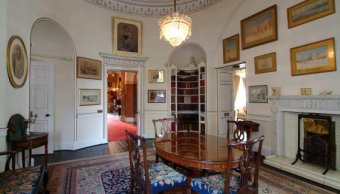 |
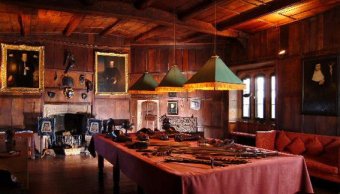 |
||||
After the tour, I had time for a quick look at the Walled Garden and the Kitchen Garden, both of which I had missed earlier, before having a satisfying but light lunch of soup, quiche and salad in the Castle Café. I then caught another City Connect service back to Harrogate and onwards to Harewood, where my second objective of the day was Harewood House. Since I've just referred to both the village and the house in the same sentence, it's probably a good time to clear up the pronunciation issue: 'hair'-wood or 'haar'-wood? When you're referring to the village, it's like the stuff on your head; when you mean the house and its estate, or the peer of the realm who owns them, it sounds like mist from the North Sea.
The house is a considerable walk from the entry point to the estate, so by the time I got to the ticket booth I felt that I had earned the substantial discount that was applied on presentation of my City Connect day ticket. A further walk soon brought me to the house itself, a magnificent 18th-century structure built by Edwin Lascelles and still owned by his descendants to this day. The first Baron Harewood wanted nothing but the best for his new home: he commissioned Yorkshire architect John Carr, interior designer Robert Adam, furniture maker Thomas Chippendale and landscape gardener Lancelot 'Capability' Brown.
My self-guided tour of the house was divided into two distinct sections, comprising the staterooms and a 'below stairs' area. The former consisted of a number of drawing rooms and sitting rooms, together with a music room and several libraries, bedrooms and dressing rooms. More formally, there was a State Dining Room and a Gallery. As well as being lavishly furnished and decorated throughout, the house featured Renaissance artwork and some impressive collections of china. The 'below stairs' section gave a fascinating glimpse of the hard work that was required in order to keep such a building functioning smoothly. As I emerged onto the rear terrace, I found myself passing through the Terrace Café and decided to pause for half an hour and treat myself to a glass of Prosecco and some chilled mineral water. Sitting outside in the warm afternoon sunshine, adjacent to such a building and overlooking the extensive formal gardens, it seemed an entirely appropriate thing to do.
 |
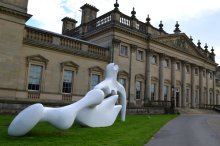 |
LEFT: Approaching Harewood House from the gatehouse |
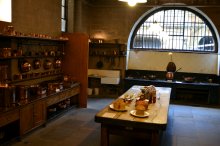 |
||
 |
RIGHT: 'Below Stairs' view | ||||
 |
 |
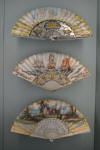 |
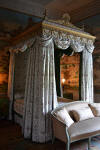 |
LEFT: Views of Harewood House interior during the self-guided tour |
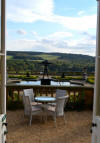 |
 |
 |
RIGHT: And so to the Terrace ... | |||
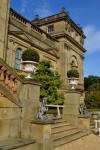 |
 |
 |
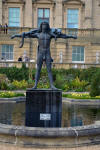 |
 |
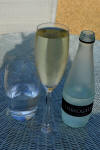 |
 |
 |
 |
|||
Dating from the 1840s, the Terrace at Harewood House is reckoned to be one of the most beautiful formal gardens in England. Its centrepiece, a striking nude statue of Orpheus by Astrid Zydower, is rather more modern, having been added in 1984 when the original statue collapsed.
I had a final look around the gardens before starting my walk out to the main road to catch the bus to Harrogate. Back at base, I watched TV for a while and had an enjoyable dinner in the hotel's dining room. A quiet night seemed in order after what had turned out to be a fairly energetic day - or at least, one where the majority of the time had been spent on my feet.